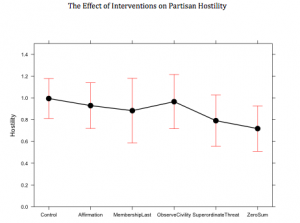The Benefits of Friendship – Behavior Edition
Context:
A main focus of intergroup relational studies relies on the ability to improve cross-group interaction and friendships. Especially prevalent in areas or communities with little to no access to an out-group, prejudice becomes a common theme and usually produces adverse effects on attitudes and opinions towards said out-group members. Christ et. al. hones in on potential contact (cross-group direct contact vs. extended indirect contact) between group members to discover a way to improve intergroup attitudes. Specifically, Christ et al. worked to understand how much of an impact extended contact, or indirect friendships with the out-group, may have on improving intergroup relations. Moreover, Christ and his colleagues study what role direct contact plays as a moderator to improving intergroup relations.
The two Hypotheses tested were:
1. The amount of extended, indirect contact for individuals who lack direct contact experience may be positively correlated to improve out-group attitudes and behavioral intentions.
2. Direct contact or cross-group friendships would promote a change in attitude strength more so than only extended, indirect contact interactions.
(Christ et al. defines contact as personal, cross-group friendships with foreigners. Extended contact is defined as indirect friendships or the knowledge of other in-group members with personal friendships with out-group members)
1. What They Did – Intervention Summary:
The second study presented by Christ et al. was focused on mixed vs. segregated religious communities within Northern Ireland. Specifically, the researchers studied the in-group, out-group relations as it pertains to protestant-catholic relations and their direct or indirect contact experiences. The contrast between protestant and catholic communities is based upon Northern Ireland’s society where religious ties and beliefs are incredibly salient. Christ and his colleagues believed this would provide the participants more specific and personal experiences to reflect upon in terms of the living environments of the participants.
Within this study, different from the first, Christ and his colleagues not only studied the effect direct and indirect contact had upon intergroup prejudice and attitude strength, but progressed to apply said experiences to behavioral intent towards the out-group. First, Christ and his colleagues asked members from both communities the amount of direct, cross-group friendships vs. indirect friendships they have. Next, also through self-report measures, the researchers assessed the level of positive behavioral intent in the form of helping or supporting behaviors towards the out-group members. This was done on a 5-point scale where higher points correlated with higher, intended positive behavior. Lastly, the researchers asses the certainty level of attitude towards the out-group, or the strength of prejudice towards the out-group members. This was done on a 4-point certainty scale (1 = extremely uncertain, 4 = extremely certain).
2. What They Found – Results:
As hypothesized, extended contact was far more connected to the intended positive behaviors towards the out-group. The authors even move say that those with very little extended contact, showed the most improvement and beneficial results in terms of intergroup relations when exposed to extended contact compared to those with simply direct contact experience. This was represented within both time periods of data collection (see sample data below). However, the second hypothesis concerning attitude strength was not correlated in the second study for direct connections did not make unique impact on the members of mixed vs. segregated groups as Study 1 discovered.
The take away? – Increasing extended group contact to those with little access to the out-group will not only significantly decrease levels of negative attitude certainty but also increase positive behavioral intentions.
3. Who Was Studied – Sample:
Two groups of individuals (results confirm for both sets):
Time 1: 984 Adults; 493 Catholics: 158 Male, 281 Female; 545 Protestants: 223 Male, 322 Female
Time 2: 404 Adults; 176 from religiously segregated neighborhoods, 228 from religiously mixed neighborhoods
4. Study Name:
Christ et al., 2010, Study 2
5. Citation:
Christ, O., Hewstone, M., Tausch, N., Wagner, U., Voci, A., Hughes, J., & Cairns, E. (2010). Direct contact as a moderator of extended contact effects: Cross-sectional and longitudinal impact on outgroup attitudes, behavioral intentions, and attitude certainty. Personality & Social Psychology Bulletin, 36(12), 1662-1674.
6. Link:
http://www.ncbi.nlm.nih.gov/pubmed/20966179
7. Intervention categories:
Intergroup relations
Attitude certainty
Behavioral intentions
Intergroup Contact
Attitude-Behavior link
8. Sample size:
1,388

